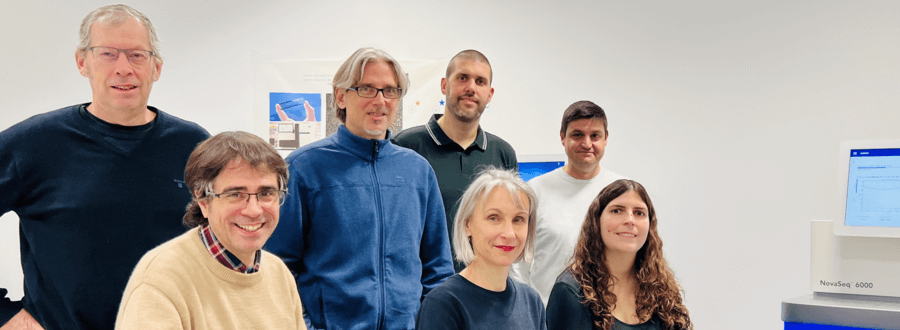
First DNA library of nearly 500 antibiotic-resistant bacteria published in Spain
The Centro Nacional de Análisis Genómico (CNAG), based in the Barcelona Science Park, Roche Diagnostics and the Complejo Hospitalario Universitario A Coruña-Instituto Investigación Biomédica A Coruña (INIBIC) have created a DNA library which provides the genomic profile of 461 antibiotic-resistant bacterial strains collected from 41 hospitals of Spain. The new database, named inCREDBle, is complemented by other scientific studies and clinical, geographic and microbiological data, becoming the most complete resource to study this class of bacteria.
Genomic sequences of bacteria hold the key to whether these bacteria can be fought with certain antibiotics or not. These genomic profiles constitute the main digital contents of the first library of nearly 500 antibiotic-resistant bacteria published in Spain.
The database has been launched by the CNAG, Roche Diagnostics and INIBIC thanks to a new genomic methodology that allows to obtain complete bacterial genomes much faster and at scale, enabling the routine monitoring of resistance transmission patterns.
The portal inCREDBle, which is the name of this DNA library, collects a total of 461 antibiotic-resistant bacterial strains which come from 41 hospitals across 13 different regions of Spain. The new database complements the genomic profile of these bacteria with clinical, geographic and microbiological data, and other online studies related to antimicrobial resistance, becoming the most comprehensive resource to study the enterobacteria, one of the families of bacteria most resistant to antibiotics. The library (https://genomes.cnag.cat/incredble/) is available for querying, browsing and downloading.
According to Tyler Alioto, author of the study and Genome Assembly and Annotation team leader at CNAG: “Complete genomic characterization of bacterial isolates can only be achieved with complete genome assemblies that resolve the main chromosome in addition to the entire complement of plasmids that they harbor and their copy number. To show that this can be done at scale we sequenced 500 antibiotic-resistant bacteria with a combination of short-read Illumina and long-read Oxford Nanopore Technologies (ONT) DNA sequencing platforms and developed an automated workflow for processing the data”.
The transmission of antibiotic resistance, key for future treatments
The objective of the Spanish research, recently published in the journal Microbial Genetics, is to provide more information to understand the mechanisms by which this resistance to drugs is being acquired or developed by species of the Enterobacterales order and the underlying mechanisms of dissemination.
“The reasons for launching a project with these characteristics and its impact are evident. One of the strategies that the US CDC (Center for Disease Control) proposes for the control of antimicrobial resistance is the surveillance and monitoring of resistant or multidrug-resistant pathogens. The work carried out between the CNAG, the CHUAC-INIBIC and Roche works with this objective and has developed a genomic database that allows the identification, localization and monitoring of gram-negative microorganisms carrying one of the most dangerous antibiotic resistance mechanisms, the enzymes called carbapenemases. This work carried out with a limited, although nationally representative number of clinical isolates can serve as a precedent for future studies with a greater number of isolates or strains and that include a greater diversity of resistant pathogens. This would allow dynamic, real-time information on the transmission of multidrug-resistant microorganisms in our country. A translational basic-clinical consortium like the one that has carried out this work is a guarantee of success in this purpose.”, highlights German Bou, author of the study and head of the Microbiology Department at Complejo Hospitalario Universitario A Coruña.
One of the main factors that contribute to antibiotic resistance in enterobacteria is the presence of carbapenemase enzymes. These enzymes have the ability to spread quickly due to their association with mobile elements and their presence in plasmids, the round DNA molecules that are transmitted from cell to cell.
The study provides new data related to the structure of plasmids, precisely for their important role in the transmission of antimicrobial resistance (AMR). An in-depth knowledge of these mechanisms could help to produce more effective treatments, that avoid antimicrobial resistance (AMR).
“High quality Microbial Genome databases are really important to understand the genetics and biology with which some of these bacteria act against antibiotics. They are a very valuable tool for research in this field, helping in the development of new diagnostic methods and therapies of high impact for these dangerous microorganisms”, affirms Miguel Álvarez-Tejado, Marketing Manager Molecular Solutions at Roche Diagnostics.
Antimicrobial resistance, at the top of the list of public health threats
The antibiotic-resistant bacteria, which are the cause of respiratory and urinary infections, has become a public health concern worldwide because of their ability to develop resistance to the most effective antibiotics to date, the carbapenem.
According to the World Health Organization (WHO), as a result of drug resistance, antibiotics become ineffective and infections become difficult or impossible to treat. The emergence and spread of drug-resistant pathogens threatens our ability to treat common infections and to perform life-saving procedures including cancer chemotherapy and caesarean section, hip replacements, organ transplantation and other surgeries.
To address that global threat, WHO has promoted a multi-pronged action plan divided into several objectives. The national study, which includes the first database of antibiotic-resistant bacteria in Spain and a new genomic methodology to generate the DNA profile of this bacteria, contributes to the second objective of this plan, related to strengthen the knowledge and evidence base through surveillance and research.
» Reference article: Alioto, Tyler S., et al. ‘Development of a Novel Streamlined Workflow (AACRE) and Database (inCREDBle) for Genomic Analysis of Carbapenem-Resistant Enterobacterales’. Microbial Genomics, vol. 9, no. 11, 2023, p. 001132. Microbiology Society Journals. DOI: https://doi.org/10.1099/mgen.0.001132.
» Link to the news: CNAG website [+]




